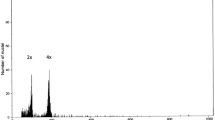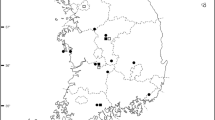Abstract
Phragmites communis Trin., a highly polymorphous and widely spread species has been described by several authors by the series of polyploidy ranging from triploid to octoploid forms (2n=36 to 96). The original spontaneous diploid form was not known. The present communication describes the experimental transplantation of a dwarf saline form into freshwater substrate conditions, including a new and extremely changed habitus of a sterile plant, the chromosome number of which has been determined as 2n=24.
Similar content being viewed by others
Literature Cited
Avdulow, N. P. (1931): Karyo-systematische Untersuchung der FamilieGramineae.-Bull. Appl. Bot., Genet. and Plant Breeding, Suppl. 43.
Björk, S. (1962): Kromosomgeografi och kromosomekologie beträffandePhragmites communis. Chromosome geography and ecology ofPhragmites communis.—Södra Sveriges Fiskeriförening Lund, 1961–1962: 1–11.
Björk, S. (1967): Ecologic investigations ofPhragmites communis.—Folia Limnol. Scand., Lund. 14: 1–248.
Conert, H. J. (1961): Die Systematik und Anatomie derArundineae.—(p. 20–63).
Dykyjová, D. (1971): Ekomorfózy a ekotypy rákosu obecnéhoPhragmites communis Trin. (Ecomorphoses and Ecotypes ofPhragmites communis Trin).—Preslia, Praha, 43: 120–138.
Dykyjová, D., Hejný, S. etKvět, J. (1973): Proposal for international comparative investigations of production by stands of reedPhragmites communis.—Folia Geobot. Phytotax, Praha, 8: 435–442.
Gorenflot, R., Raicu, P., Cartier, D., Ciobanu, I., Stoian, V. etStaicu, S. (1972): Le complexe polyploide duPhragmites communis Trin.—Comptes Rendus Acad. Sc. Paris, Sér. D, 274: 1501–1504.
Gustafsson, Å. etSimak, M. (1963): X-ray photography and seed sterility inPhragmites communis Trin.—Hereditas, Lund, 49: 442–450.
Hejný, S. (1960): Ökologische Charakteristik der Wasser- und Sumpfpflanzen in der Slowakischen Tiefebenen (Donau- und Theissgebiet). Bratislava.
Heurteaux, P. (1962): L'eau et le sel en Camargue. Position du problème et resultats des premières recherches.—La Terre et la Vie, Paris 109: 11–33.
Hofmann, L. (1958): An ecological sketch of the Camargue.—British birds, 51: 321–349.
Lenoir, A., Stoian, V., Cartier, D., Gorenflot, R. etRaicu, P. (1975): Polyploidie et méiose pollinique duPhragmites australis (Cav.)Trin. exSteud.—Comptes Rendus Acad. Sci. Paris, Sér. D, 280: 621–624.
Löve, A. etLöve, D. (1961): Chromosome numbers of central and northwest European plant species.—Opera Bot., Lund.
Pazourková, Z. (1973): Caryology of some forms ofPhragmites communis Trin.—In:Hejný, S. (Ed.): Ecosystem study on wetland biome in Czechoslovakia.—IBP/PT-PP Report No 3, Třeboň, p. 59–62.
Podpěra, J. (1925): Květena Moravy. Vol. 6, Pars 2. Trávy.—Práce Mor. Přírod. Spol., 2/10, Brno.
Popov, B. A., Dostanova, R. Ch. etPrichodko, L. S. (1970): Struktura í funkcija kletok rastěnij pri zasolenii. (Structure and function of plant cells under salinity). Moskva.
Raicu, P., Staicu, S., Stoian, V. etRoman, T. (1972): ThePhragmites communis Trin. chromosome complement in the Danube Delta.—Hydrobiologia, The Hague, 39: 83–89.
Rothmaler, W. (1963): Exkursionsflora von Deutschland. Kritischer Ergänzungsband.—Berlin.
Stoian, V., Lenoir, A., Raicu, P. etGorenflot, R. (1974): La méoise et la taille polliniques d'individus octoploides duPhragmites australis (Cav.)Trin. exSteud.—Comptes Rendus Acad. Sci. Paris, Sér. D, 278: 457–459.
Strogonov, B. P., (1962): Fiziologičeskije osnovy soleustrojčivosti rastěnij. (Physiological bases of salt tolerance in plants).—Moskva.
Strogonov, B. P., Kabanov, V. V., Ševjakova, N. I., Lapina, L. P., Komiserko, E. J., Popov, B. A. Dostanova, R. CH., etPrichodko, L. S., (1970): Struktura i funkcija kletok rastěnij pri zasolenii. (Structure and function of plant cells under salinity). Moskva.
Tallon, G. (1958): La végétation de Camargue; groupements plus particuliers au delta.—83e congrés National des Sociétés Savantes Colloque sur la Camargue. (sec.Hoffmann, L., 1958).
Tallon, G., (1959): Les sols alcalins de Camargue et leur végétation.—In: La Terre et la Vie, Paris, 106: 1–17.
Tarnavschi, I. T., (1948): Die Chromosomenzahlen der Anthophyten-Flora von Rumäníen mit einem Ausblick auf das Polyploidie-Problem.—Bull. Jard. Mus. Bot. Cluj., Suppl., 28, 1–130.
Toorn van der, J. (1971): Investigations on the ecological differentiation ofPhragmites communis Trin. in the Netherlands.—Hidrobiologia, Bucuresti, 12: 97–106.
Toorn van der, J. (1972): Variability ofPhragmites australis (Cav.)Trin. ex Steduel in relation to the environment.—Van Zee Tot Land, p. 1–122.
Whyte, R. O. (1973): Cytogenetical response to physiological stress.—Second SABRAO Congress, I. A. R. I., New Delni, Febr. 1973.
Author information
Authors and Affiliations
Rights and permissions
About this article
Cite this article
Dykyjová, D., Pazourková, Z. A diploid form ofPhragmites communis, as a possible result of cytogenetical response to ecological stress. Folia geobot. phytotax. 14, 113–120 (1979). https://doi.org/10.1007/BF02854607
Received:
Issue Date:
DOI: https://doi.org/10.1007/BF02854607




